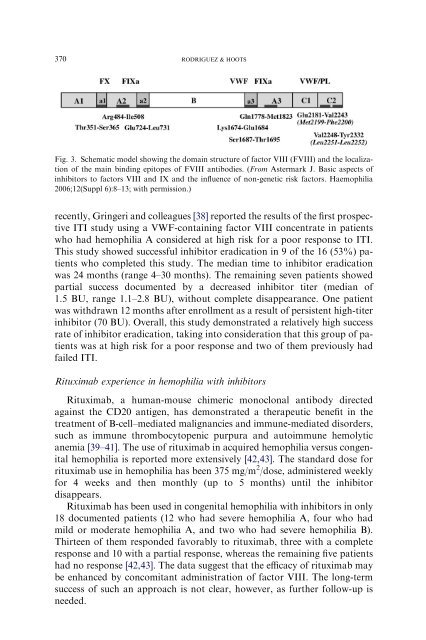Pediatric Clinics of North America - CIPERJ
Pediatric Clinics of North America - CIPERJ
Pediatric Clinics of North America - CIPERJ
Create successful ePaper yourself
Turn your PDF publications into a flip-book with our unique Google optimized e-Paper software.
370 RODRIGUEZ & HOOTS<br />
Fig. 3. Schematic model showing the domain structure <strong>of</strong> factor VIII (FVIII) and the localization<br />
<strong>of</strong> the main binding epitopes <strong>of</strong> FVIII antibodies. (From Astermark J. Basic aspects <strong>of</strong><br />
inhibitors to factors VIII and IX and the influence <strong>of</strong> non-genetic risk factors. Haemophilia<br />
2006;12(Suppl 6):8–13; with permission.)<br />
recently, Gringeri and colleagues [38] reported the results <strong>of</strong> the first prospective<br />
ITI study using a VWF-containing factor VIII concentrate in patients<br />
who had hemophilia A considered at high risk for a poor response to ITI.<br />
This study showed successful inhibitor eradication in 9 <strong>of</strong> the 16 (53%) patients<br />
who completed this study. The median time to inhibitor eradication<br />
was 24 months (range 4–30 months). The remaining seven patients showed<br />
partial success documented by a decreased inhibitor titer (median <strong>of</strong><br />
1.5 BU, range 1.1–2.8 BU), without complete disappearance. One patient<br />
was withdrawn 12 months after enrollment as a result <strong>of</strong> persistent high-titer<br />
inhibitor (70 BU). Overall, this study demonstrated a relatively high success<br />
rate <strong>of</strong> inhibitor eradication, taking into consideration that this group <strong>of</strong> patients<br />
was at high risk for a poor response and two <strong>of</strong> them previously had<br />
failed ITI.<br />
Rituximab experience in hemophilia with inhibitors<br />
Rituximab, a human-mouse chimeric monoclonal antibody directed<br />
against the CD20 antigen, has demonstrated a therapeutic benefit in the<br />
treatment <strong>of</strong> B-cell–mediated malignancies and immune-mediated disorders,<br />
such as immune thrombocytopenic purpura and autoimmune hemolytic<br />
anemia [39–41]. The use <strong>of</strong> rituximab in acquired hemophilia versus congenital<br />
hemophilia is reported more extensively [42,43]. The standard dose for<br />
rituximab use in hemophilia has been 375 mg/m 2 /dose, administered weekly<br />
for 4 weeks and then monthly (up to 5 months) until the inhibitor<br />
disappears.<br />
Rituximab has been used in congenital hemophilia with inhibitors in only<br />
18 documented patients (12 who had severe hemophilia A, four who had<br />
mild or moderate hemophilia A, and two who had severe hemophilia B).<br />
Thirteen <strong>of</strong> them responded favorably to rituximab, three with a complete<br />
response and 10 with a partial response, whereas the remaining five patients<br />
had no response [42,43]. The data suggest that the efficacy <strong>of</strong> rituximab may<br />
be enhanced by concomitant administration <strong>of</strong> factor VIII. The long-term<br />
success <strong>of</strong> such an approach is not clear, however, as further follow-up is<br />
needed.





